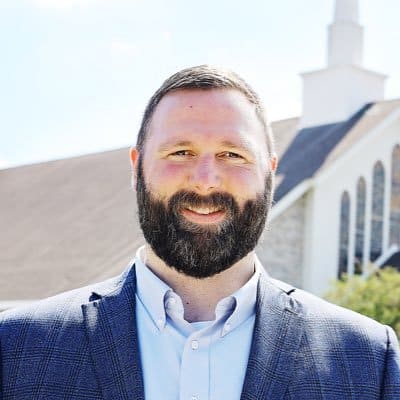Communicators, especially those within the evangelical community, love to use alliteration. It can be a helpful literary tool for impressing the points of a sermon or other spoken or written work upon the minds of an audience. Then there are those times when forcing alliteration leads to some sticky messaging. Such is the case with the phrase “worship and the Word,” often used by church leaders to cleverly describe a gathering that contains music and preaching—“Join us this Sunday for worship and the Word!”
At least two things are problematic with this description. First, it creates a false dichotomy by equating worship with music, as if preaching is not worship. Second, such distinctions either elevate these items over all other elements of worship, or worse, limit a gathering to music and preaching, to the neglect of other biblically-ordained worship practices.
An appropriate understanding of these terms, however, does not create a dichotomy, but rather, unites worship with the Word. This union recognizes that the Word of God should regulate, provide, and inform the elements, shape, and substance of corporate worship.
The Word Regulates the Elements of Worship
The first step in exploring the marriage between worship and the Word is to determine exactly what elements should be included in corporate worship, which raises the question of whether God cares what we include or not. All can agree that what God forbids should be excluded, but much debate exists between including only that which God has commanded (the regulative principle of worship)1For a thorough treatment of the Regulative Principle see Ligon Duncan’s excellent chapters “Does God Care How We Worship?” and “Foundations for Biblically Directed in Worship” in Give … Continue reading or allowing anything that God has not forbidden (the normative principle of worship). Several arguments can be made for why the regulative principle is the most biblical conclusion. One such argument is found in the outcome of Nadab’s and Abihu’s attempts at worship in Leviticus 10:1–2:
Now Nadab and Abihu, the sons of Aaron, each took his censer and put fire in it and laid incense on it and offered unauthorized fire before the Lord, which he had not commanded them. And fire came out from before the Lord and consumed them, and they died before the Lord.
Previously, God had both initiated worship and commanded the instructions for worship, to which God’s people were obedient (Lev 8:1–4); yet here we see Nadab and Abihu initiating worship apart from God’s command. The error was not simply that they were worshiping in a way that God had forbidden, but that they had offered “unauthorized” worship, “which he had not commanded them.” In our worship, then, we should submit to only that which God has commanded or shown in his Word.
Because Christ’s sacrificial death fulfills old covenant worship practices, we specifically look to the New Testament for instruction in corporate worship. Here we find seven elements of worship:
- Reading of Scripture (1 Tim 4:13)
- Preaching (2 Tim 4:2)
- Singing (Col 3:16; Eph 5:19)
- Prayer (Matt 21:13; 1 Tim 2:1)
- Giving (1 Cor 16:2)
- Baptism (Matt 28:19)
- The Lord’s Supper (1 Cor 11:26)
While we may have noble reasons for including other elements in worship, the best way we can be faithful to worshiping God as he desires is to limit our worship to that which he has revealed to us in his Word.
The Word Provides the Shape of Worship
Once we have determined what should be included in worship, we are then left with the task of putting the service in a particular order. Unlike the elements above, we do not have a biblically prescribed liturgy. However, we are instructed that our worship be orderly (1 Cor 14:26–40), and Scripture does reveal to us a common pattern, seen at a macro level (the whole of Scripture) and at micro levels (specific passages throughout Scripture). Consider Israel’s first service of worship:
Then he said to Moses, “Come up to the Lord, you and Aaron, Nadab, and Abihu, and seventy of the elders of Israel, and worship from afar. 2 Moses alone shall come near to the Lord, but the others shall not come near, and the people shall not come up with him.” 3 Moses came and told the people all the words of the Lord and all the rules. And all the people answered with one voice and said, “All the words that the Lord has spoken we will do.” 4 And Moses wrote down all the words of the Lord. He rose early in the morning and built an altar at the foot of the mountain, and twelve pillars, according to the twelve tribes of Israel. 5 And he sent young men of the people of Israel, who offered burnt offerings and sacrificed peace offerings of oxen to the Lord. 6 And Moses took half of the blood and put it in basins, and half of the blood he threw against the altar. 7 Then he took the Book of the Covenant and read it in the hearing of the people. And they said, “All that the Lord has spoken we will do, and we will be obedient.” 8 And Moses took the blood and threw it on the people and said, “Behold the blood of the covenant that the Lord has made with you in accordance with all these words.” 9 Then Moses and Aaron, Nadab, and Abihu, and seventy of the elders of Israel went up, 10 and they saw the God of Israel. There was under his feet as it were a pavement of sapphire stone, like the very heaven for clearness. 11 And he did not lay his hand on the chief men of the people of Israel; they beheld God, and ate and drank.
Exod 24:1–11
In this passage we see God calling his people to worship (v. 1), yet because of their sin, the people were not allowed to fully come into the presence of God (v. 2). Afterwards, Moses made atonement for the people (vv. 4–6). Following the sacrifices, Moses proclaimed God’s Word, to which the people responded in commitment and promised obedience (v. 7). The people were then consecrated (v. 8) and welcomed into the presence of God to eat and drink (v. 11). We can see similar patterns in the first service in the tabernacle (Lev 9), the dedication of the temple (2 Chron 5–7), and Isaiah’s (Is 6) and John’s (Rev 4–5) visions of heavenly worship. This pattern is summarized in the following gospel-shaped order:
- Revelation
- Adoration
- Confession
- Propitiation
- Proclamation
- Dedication
- Supplication
- Communion
- Commission
Because the gospel is the most commonly-revealed pattern in Scripture—indeed, even the overarching shape of God’s Word, and because it is the gospel that makes our worship possible, it makes sense that our worship would take on this same progression.2For a more detailed explanation of gospel-ordered worship, see Matt Sikes’s lesson in G3’s worship curriculum.
The Word Informs the Substance of Worship
Not only does the Word regulate the elements of worship and provide a gospel-shape to our worship, but it also should inform the substance and content of our worship. This should be an obvious characteristic of activities like the public reading of Scripture and preaching, but even our songs and prayers should be filled with the Words of God as his people seek to “be filled with the Spirit” (Eph 5:18) as “the Word of Christ dwell[s] in [them] richly” (Col 3:16). In this, then, wisdom acknowledges that anything we say, read, sing, or pray is made infinitely better when it is informed by the Word of God. Part of worshiping in “spirit and truth” (John 4:23–24) is to make sure that the content of our worship is filled with truth. Because God is the source of truth, this kind of worship is impossible apart from the God’s Word. Therefore, our worship should be filled with the Word of God, the only source of truth and the Word of Christ. When this happens, it can be said that we gather to read the Word, sing the Word, preach the Word, pray the Word, and even see the Word in the Lord’s Supper and baptism.
One particular way we can add cohesion to our service and implement the concept of God’s Word informing the elements is to use the sermon text as the primary—but certainly not the only— biblical passage from which we pull. This requires the worship planner to do similar exegetical study to that of the expositional preacher.3I highly recommend the G3 Expository Preaching Workshops. Not only do these equip preachers well, but they are also incredibly helpful to the worship planner to come to the right conclusions about a … Continue reading
Once we’ve identified the structure, emphasis, theme, aim, central proposition, and connections to the person and work of Christ, we are then ready to let that text inform the elements. I find it helpful to start with the gospel-shaped liturgical themes above and ask the question, “What does the text reveal about who God is, who we are, what Christ has done for us, how we ought to respond, etc.?” The answers to these questions can then fill our songs and prayers and help us select the best readings. For example, is God’s holiness emphasized in the text? Then perhaps select a song like “Holy, Holy, Holy” as a response of adoration. This unity throughout the service, then, effectively contributes to the building up of the body of Christ.
Worship and the Word
This understanding of worship—worship whose elements are regulated by the Word, whose shape is provided by the Word, and whose substance is informed by the Word—rightly submits itself to the authority of God’s Word. In this way, God’s people must take care in how they worship God, for he has said, “Among those who are near me I will be sanctified, and before all the people I will be glorified” (Lev 10:3). May we be found faithful.
Any pastors or men who have a worship planning role—or simply hope to one day—and have found this article helpful, I invite you to join us for a G3 Biblical Worship Workshop where we will flesh out these things and many others and work together in equipping men to faithfully serve their church in worship.
References
| 1 | For a thorough treatment of the Regulative Principle see Ligon Duncan’s excellent chapters “Does God Care How We Worship?” and “Foundations for Biblically Directed in Worship” in Give Praise to God: A Vision for Reforming Worship: Celebrating the Legacy of James Montgomery Boice (Phillipsburg, NJ: P&R Publishing, 2003). |
|---|---|
| 2 | For a more detailed explanation of gospel-ordered worship, see Matt Sikes’s lesson in G3’s worship curriculum. |
| 3 | I highly recommend the G3 Expository Preaching Workshops. Not only do these equip preachers well, but they are also incredibly helpful to the worship planner to come to the right conclusions about a particular passage as he plans worship around the Word. For a case for expositional preaching, check out this article by Tom Buck, the Director of G3 Expository Preaching Workshops. |




